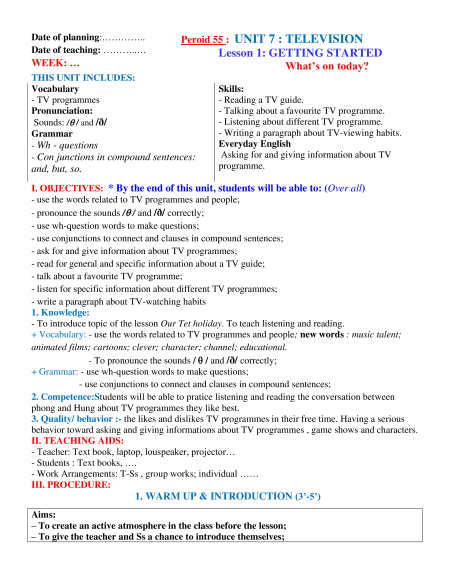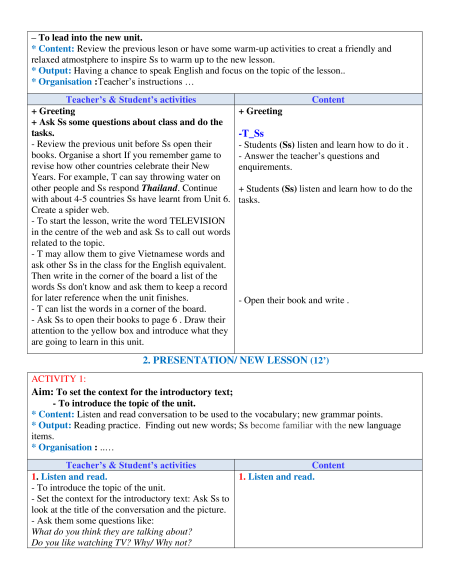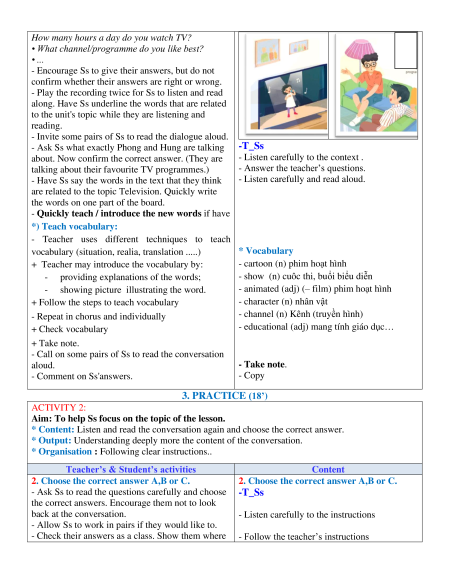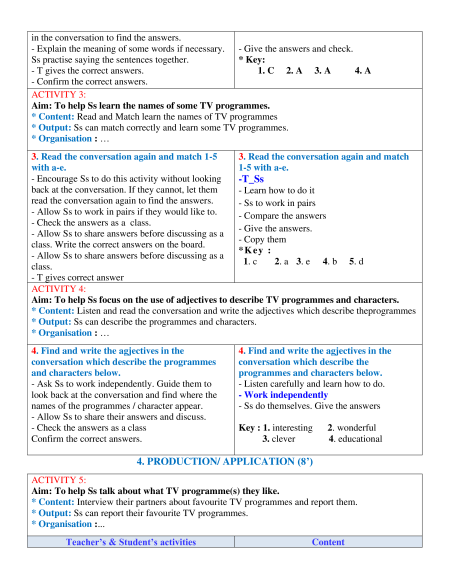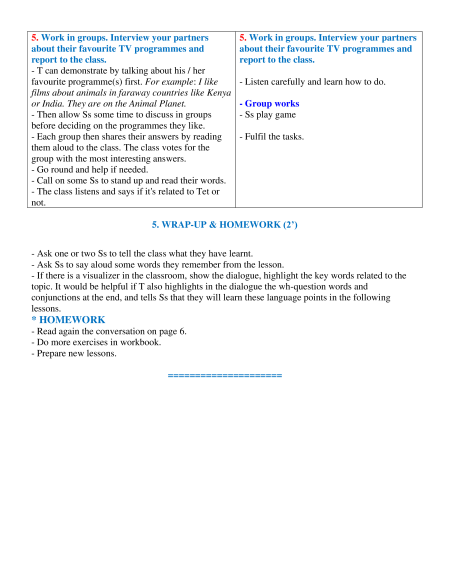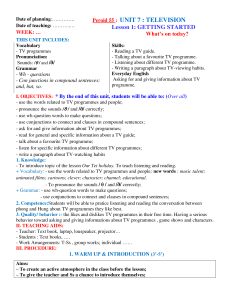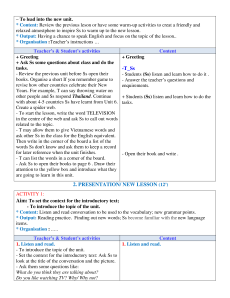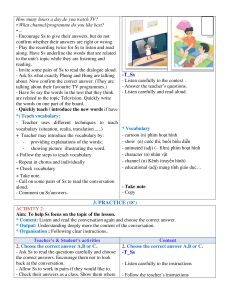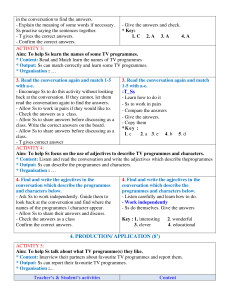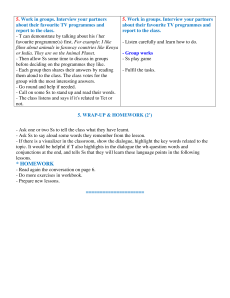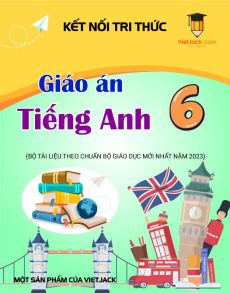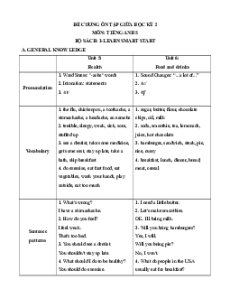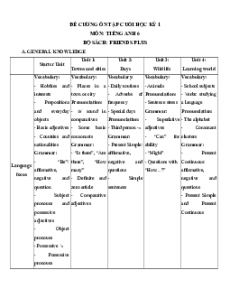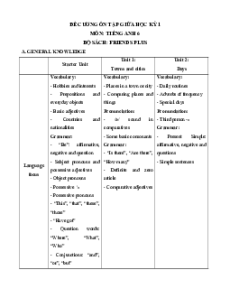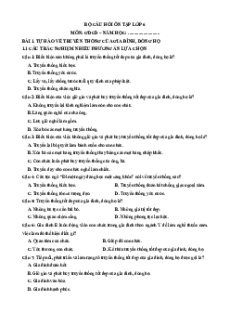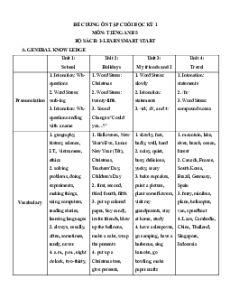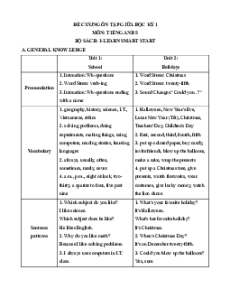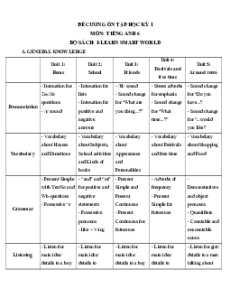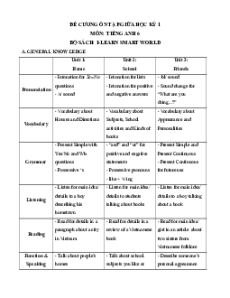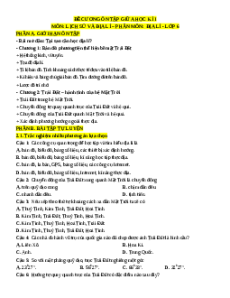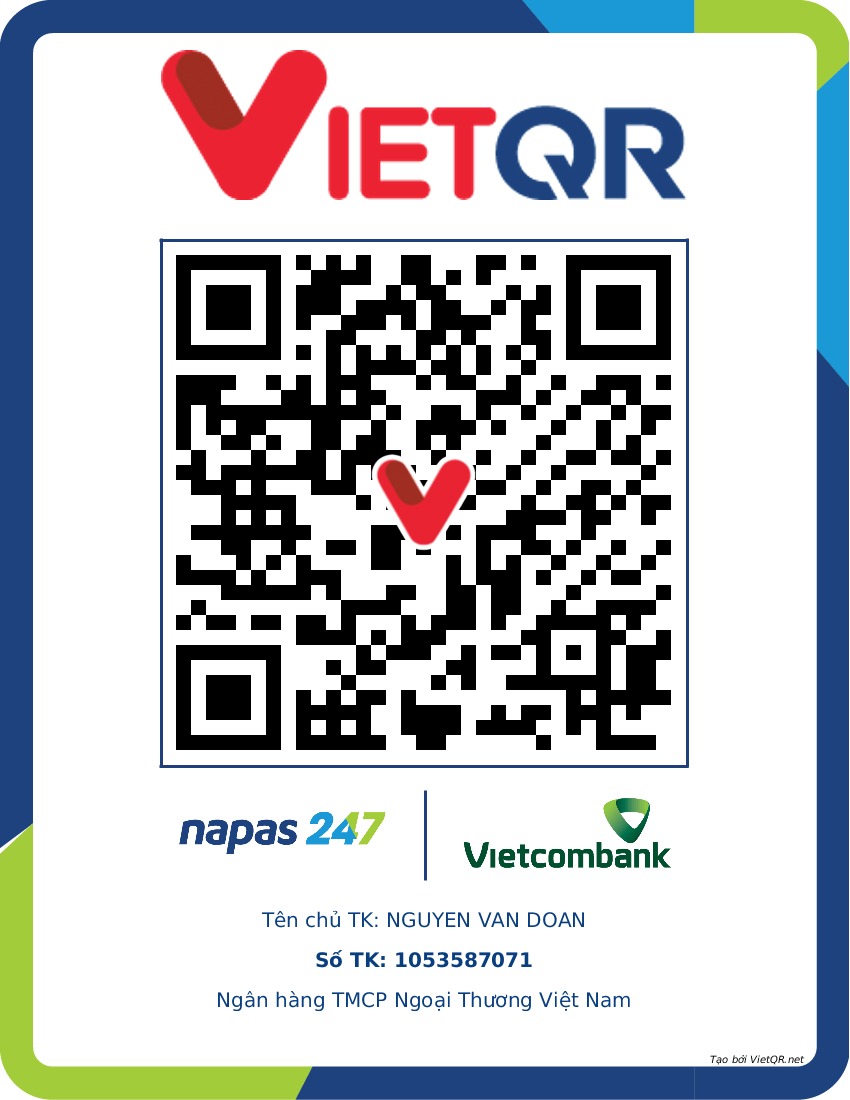Date of planning:…………..
Peroid 55 : UNIT 7 : TELEVISION
Date of teaching: ………..…
Lesson 1: GETTING STARTED WEEK: … What’s on today? THIS UNIT INCLUDES: Vocabulary Skills: - TV programmes - Reading a TV guide. Pronunciation:
- Talking about a favourite TV programme.
Sounds: / / and /ð/
- Listening about different TV programme. Grammar
- Writing a paragraph about TV-viewing habits. - Wh - questions Everyday English
- Con junctions in compound sentences:
Asking for and giving information about TV and, but, so. programme.
I. OBJECTIVES: * By the end of this unit, students will be able to: (Over all)
- use the words related to TV programmes and people;
- pronounce the sounds / / and /ð/ correctly;
- use wh-question words to make questions;
- use conjunctions to connect and clauses in compound sentences;
- ask for and give information about TV programmes;
- read for general and specific information about a TV guide;
- talk about a favourite TV programme;
- listen for specific information about different TV programmes;
- write a paragraph about TV-watching habits 1. Knowledge:
- To introduce topic of the lesson Our Tet holiday. To teach listening and reading.
+ Vocabulary: - use the words related to TV programmes and people; new words : music talent;
animated films; cartoons; clever; character; channel; educational.
- To pronounce the sounds / / and /ð/ correctly;
+ Grammar: - use wh-question words to make questions;
- use conjunctions to connect and clauses in compound sentences;
2. Competence:Students will be able to pratice listening and reading the conversation between
phong and Hung about TV programmes they like best.
3. Quality/ behavior :- the likes and dislikes TV programmes in their free time. Having a serious
behavior toward asking and giving informations about TV programmes , game shows and characters. II. TEACHING AIDS:
- Teacher: Text book, laptop, louspeaker, projector… - Students : Text books, ….
- Work Arrangements: T-Ss , group works; individual …… III. PROCEDURE:
1. WARM UP & INTRODUCTION (3’-5’) Aims:
– To create an active atmosphere in the class before the lesson;
– To give the teacher and Ss a chance to introduce themselves;
– To lead into the new unit.
* Content: Review the previous leson or have some warm-up activities to creat a friendly and
relaxed atmostphere to inspire Ss to warm up to the new lesson.
* Output: Having a chance to speak English and focus on the topic of the lesson..
* Organisation :Teacher’s instructions …
Teacher’s & Student’s activities Content + Greeting + Greeting
+ Ask Ss some questions about class and do the tasks. -T_Ss
- Review the previous unit before Ss open their
- Students (Ss) listen and learn how to do it .
books. Organise a short If you remember game to
- Answer the teacher’s questions and
revise how other countries celebrate their New enquirements.
Years. For example, T can say throwing water on
other people and Ss respond Thailand. Continue
+ Students (Ss) listen and learn how to do the
with about 4-5 countries Ss have learnt from Unit 6. tasks. Create a spider web.
- To start the lesson, write the word TELEVISION
in the centre of the web and ask Ss to call out words related to the topic.
- T may allow them to give Vietnamese words and
ask other Ss in the class for the English equivalent.
Then write in the corner of the board a list of the
words Ss don't know and ask them to keep a record
for later reference when the unit finishes. - Open their book and write .
- T can list the words in a corner of the board.
- Ask Ss to open their books to page 6 . Draw their
attention to the yellow box and introduce what they
are going to learn in this unit.
2. PRESENTATION/ NEW LESSON (12’) ACTIVITY 1:
Aim: To set the context for the introductory text;
- To introduce the topic of the unit.
* Content: Listen and read conversation to be used to the vocabulary; new grammar points.
* Output: Reading practice. Finding out new words; Ss become familiar with the new language items. * Organisation : ..…
Teacher’s & Student’s activities Content 1. Listen and read. 1. Listen and read.
- To introduce the topic of the unit.
- Set the context for the introductory text: Ask Ss to
look at the title of the conversation and the picture.
- Ask them some questions like:
What do you think they are talking about?
Do you like watching TV? Why/ Why not?
How many hours a day do you watch TV?
• What channel/programme do you like best? • ...
- Encourage Ss to give their answers, but do not
confirm whether their answers are right or wrong.
- Play the recording twice for Ss to listen and read
along. Have Ss underline the words that are related
to the unit's topic while they are listening and reading.
- Invite some pairs of Ss to read the dialogue aloud.
- Ask Ss what exactly Phong and Hung are talking -T_Ss
about. Now confirm the correct answer. (They are
- Listen carefully to the context .
talking about their favourite TV programmes.)
- Answer the teacher’s questions.
- Have Ss say the words in the text that they think
- Listen carefully and read aloud.
are related to the topic Television. Quickly write
the words on one part of the board.
- Quickly teach / introduce the new words if have *) Teach vocabulary:
- Teacher uses different techniques to teach
vocabulary (situation, realia, translation .....) * Vocabulary
+ Teacher may introduce the vocabulary by:
- cartoon (n) phim hoạt hình
- providing explanations of the words;
- show (n) cuôc thi, buổi biểu diễn
- showing picture illustrating the word.
- animated (adj) (– film) phim hoạt hình
+ Follow the steps to teach vocabulary - character (n) nhân vật
- Repeat in chorus and individually
- channel (n) Kênh (truyền hình) + Check vocabulary
- educational (adj) mang tính giáo dục… + Take note.
- Call on some pairs of Ss to read the conversation aloud. - Take note. - Comment on Ss'answers. - Copy 3. PRACTICE (18’) ACTIVITY 2:
Aim: To help Ss focus on the topic of the lesson.
* Content: Listen and read the conversation again and choose the correct answer.
* Output: Understanding deeply more the content of the conversation.
* Organisation : Following clear instructions..
Teacher’s & Student’s activities Content
2. Choose the correct answer A,B or C.
2. Choose the correct answer A,B or C.
- Ask Ss to read the questions carefully and choose -T_Ss
the correct answers. Encourage them not to look back at the conversation.
- Listen carefully to the instructions
- Allow Ss to work in pairs if they would like to.
- Check their answers as a class. Show them where
- Follow the teacher’s instructions
in the conversation to find the answers.
- Explain the meaning of some words if necessary. - Give the answers and check.
Ss practise saying the sentences together. * Key:
- T gives the correct answers.
1. C 2. A 3. A 4. A
- Confirm the correct answers. ACTIVITY 3:
Aim: To help Ss learn the names of some TV programmes.
* Content: Read and Match learn the names of TV programmes
* Output: Ss can match correctly and learn some TV programmes. * Organisation : …
3. Read the conversation again and match 1-5
3. Read the conversation again and match with a-e. 1-5 with a-e.
- Encourage Ss to do this activity without looking -T_Ss
back at the conversation. If they cannot, let them - Learn how to do it
read the conversation again to find the answers. - Ss to work in pairs
- Allow Ss to work in pairs if they would like to. - Compare the answers
- Check the answers as a class. - Give the answers.
- Allow Ss to share answers before discussing as a - Copy them
class. Write the correct answers on the board. * K e y :
- Allow Ss to share answers before discussing as a
1. c 2. a 3. e 4. b 5. d class. - T gives correct answer ACTIVITY 4:
Aim: To help Ss focus on the use of adjectives to describe TV programmes and characters.
* Content: Listen and read the conversation and write the adjectives which describe theprogrammes
* Output: Ss can describe the programmes and characters. * Organisation : …
4. Find and write the agjectives in the
4. Find and write the agjectives in the
conversation which describe the programmes
conversation which describe the and characters below.
programmes and characters below.
- Ask Ss to work independently. Guide them to
- Listen carefully and learn how to do.
look back at the conversation and find where the - Work independently
names of the programmes / character appear.
- Ss do themselves. Give the answers
- Allow Ss to share their answers and discuss.
- Check the answers as a class
Key : 1. interesting 2. wonderful Confirm the correct answers.
3. clever 4. educational
4. PRODUCTION/ APPLICATION (8’) ACTIVITY 5:
Aim: To help Ss talk about what TV programme(s) they like.
* Content: Interview their partners about favourite TV programmes and report them.
* Output: Ss can report their favourite TV programmes. * Organisation :...
Teacher’s & Student’s activities Content
Giáo án Unit 7: Television Tiếng Anh 6 Global success
689
345 lượt tải
MUA NGAY ĐỂ XEM TOÀN BỘ TÀI LIỆU
CÁCH MUA:
- B1: Gửi phí vào TK:
1133836868- CT TNHH DAU TU VA DV GD VIETJACK - Ngân hàng MB (QR) - B2: Nhắn tin tới Zalo VietJack Official ( nhấn vào đây ) để xác nhận thanh toán và tải tài liệu - giáo án
Liên hệ ngay Hotline hỗ trợ: 084 283 45 85
Bộ giáo án Tiếng anh 6 Global success được cập nhật liên tục trong gói này từ nay đến hết tháng 3/2024.
Để tải tài liệu gốc về máy bạn click vào nút Tải Xuống ở trên!
Thuộc bộ (mua theo bộ để tiết kiệm hơn):
- Bộ giáo án Tiếng anh 6 Global success năm 2023 mới, chuẩn nhất được thiết kế theo phong cách hiện đại, đẹp mắt, trình bày chi tiết cho từng bài học và bám sát chương trình Sách giáo khoa Tiếng anh 6 Global success.
- Mua trọn bộ sẽ tiết kiệm hơn tải lẻ 50%.
Đánh giá
4.6 / 5(689 )5
4
3
2
1
Trọng Bình
Tài liệu hay
Giúp ích cho tôi rất nhiều
Duy Trần
Tài liệu chuẩn
Rất thích tài liệu bên VJ soạn (bám sát chương trình dạy)
TÀI LIỆU BỘ BÁN CHẠY MÔN Tiếng Anh
Xem thêmTÀI LIỆU BỘ BÁN CHẠY Lớp 6
Xem thêmTài liệu bộ mới nhất

Date of planning:…………..
Date of teaching: ………..…
WEEK: …
Peroid 55 : UNIT 7 : TELEVISION
Lesson 1: GETTING STARTED
What’s on today?
THIS UNIT INCLUDES:
Vocabulary
- TV programmes
Pronunciation:
Sounds: /
/ and /ð/
Grammar
- Wh - questions
- Con junctions in compound sentences:
and, but, so.
Skills:
- Reading a TV guide.
- Talking about a favourite TV programme.
- Listening about different TV programme.
- Writing a paragraph about TV-viewing habits.
Everyday English
Asking for and giving information about TV
programme.
I. OBJECTIVES: * By the end of this unit, students will be able to: (Over all)
- use the words related to TV programmes and people;
- pronounce the sounds /
/ and /ð/ correctly;
- use wh-question words to make questions;
- use conjunctions to connect and clauses in compound sentences;
- ask for and give information about TV programmes;
- read for general and specific information about a TV guide;
- talk about a favourite TV programme;
- listen for specific information about different TV programmes;
- write a paragraph about TV-watching habits
1. Knowledge:
- To introduce topic of the lesson Our Tet holiday. To teach listening and reading.
+ Vocabulary: - use the words related to TV programmes and people; new words : music talent;
animated films; cartoons; clever; character; channel; educational.
- To pronounce the sounds / / and /ð/ correctly;
+ Grammar: - use wh-question words to make questions;
- use conjunctions to connect and clauses in compound sentences;
2. Competence:Students will be able to pratice listening and reading the conversation between
phong and Hung about TV programmes they like best.
3. Quality/ behavior :- the likes and dislikes TV programmes in their free time. Having a serious
behavior toward asking and giving informations about TV programmes , game shows and characters.
II. TEACHING AIDS:
- Teacher: Text book, laptop, louspeaker, projector…
- Students : Text books, ….
- Work Arrangements: T-Ss , group works; individual ……
III. PROCEDURE:
1. WARM UP & INTRODUCTION (3’-5’)
Aims:
– To create an active atmosphere in the class before the lesson;
– To give the teacher and Ss a chance to introduce themselves;

– To lead into the new unit.
* Content: Review the previous leson or have some warm-up activities to creat a friendly and
relaxed atmostphere to inspire Ss to warm up to the new lesson.
* Output: Having a chance to speak English and focus on the topic of the lesson..
* Organisation :Teacher’s instructions …
Teacher’s & Student’s activities
Content
+ Greeting
+ Ask Ss some questions about class and do the
tasks.
- Review the previous unit before Ss open their
books. Organise a short If you remember game to
revise how other countries celebrate their New
Years. For example, T can say throwing water on
other people and Ss respond Thailand. Continue
with about 4-5 countries Ss have learnt from Unit 6.
Create a spider web.
- To start the lesson, write the word TELEVISION
in the centre of the web and ask Ss to call out words
related to the topic.
- T may allow them to give Vietnamese words and
ask other Ss in the class for the English equivalent.
Then write in the corner of the board a list of the
words Ss don't know and ask them to keep a record
for later reference when the unit finishes.
- T can list the words in a corner of the board.
- Ask Ss to open their books to page 6 . Draw their
attention to the yellow box and introduce what they
are going to learn in this unit.
+ Greeting
-T_Ss
- Students (Ss) listen and learn how to do it .
- Answer the teacher’s questions and
enquirements.
+ Students (Ss) listen and learn how to do the
tasks.
- Open their book and write .
2. PRESENTATION/ NEW LESSON (12’)
ACTIVITY 1:
Aim: To set the context for the introductory text;
- To introduce the topic of the unit.
* Content: Listen and read conversation to be used to the vocabulary; new grammar points.
* Output: Reading practice. Finding out new words; Ss become familiar with the new language
items.
* Organisation : ..…
Teacher’s & Student’s activities
Content
1. Listen and read.
- To introduce the topic of the unit.
- Set the context for the introductory text: Ask Ss to
look at the title of the conversation and the picture.
- Ask them some questions like:
What do you think they are talking about?
Do you like watching TV? Why/ Why not?
1. Listen and read.

How many hours a day do you watch TV?
• What channel/programme do you like best?
• ...
- Encourage Ss to give their answers, but do not
confirm whether their answers are right or wrong.
- Play the recording twice for Ss to listen and read
along. Have Ss underline the words that are related
to the unit's topic while they are listening and
reading.
- Invite some pairs of Ss to read the dialogue aloud.
- Ask Ss what exactly Phong and Hung are talking
about. Now confirm the correct answer. (They are
talking about their favourite TV programmes.)
- Have Ss say the words in the text that they think
are related to the topic Television. Quickly write
the words on one part of the board.
- Quickly teach / introduce the new words if have
*) Teach vocabulary:
- Teacher uses different techniques to teach
vocabulary (situation, realia, translation .....)
+ Teacher may introduce the vocabulary by:
- providing explanations of the words;
- showing picture illustrating the word.
+ Follow the steps to teach vocabulary
- Repeat in chorus and individually
+ Check vocabulary
+ Take note.
- Call on some pairs of Ss to read the conversation
aloud.
- Comment on Ss'answers.
-T_Ss
- Listen carefully to the context .
- Answer the teacher’s questions.
- Listen carefully and read aloud.
* Vocabulary
- cartoon (n) phim hoạt hình
- show (n) cuôc thi, buổi biểu diễn
- animated (adj) (– film) phim hoạt hình
- character (n) nhân vật
- channel (n) Kênh (truyền hình)
- educational (adj) mang tính giáo dục…
- Take note.
- Copy
3. PRACTICE (18’)
ACTIVITY 2:
Aim: To help Ss focus on the topic of the lesson.
* Content: Listen and read the conversation again and choose the correct answer.
* Output: Understanding deeply more the content of the conversation.
* Organisation : Following clear instructions..
Teacher’s & Student’s activities
Content
2. Choose the correct answer A,B or C.
- Ask Ss to read the questions carefully and choose
the correct answers. Encourage them not to look
back at the conversation.
- Allow Ss to work in pairs if they would like to.
- Check their answers as a class. Show them where
2. Choose the correct answer A,B or C.
-T_Ss
- Listen carefully to the instructions
- Follow the teacher’s instructions

in the conversation to find the answers.
- Explain the meaning of some words if necessary.
Ss practise saying the sentences together.
- T gives the correct answers.
- Confirm the correct answers.
- Give the answers and check.
* Key:
1. C 2. A 3. A 4. A
ACTIVITY 3:
Aim: To help Ss learn the names of some TV programmes.
* Content: Read and Match learn the names of TV programmes
* Output: Ss can match correctly and learn some TV programmes.
* Organisation : …
3. Read the conversation again and match 1-5
with a-e.
- Encourage Ss to do this activity without looking
back at the conversation. If they cannot, let them
read the conversation again to find the answers.
- Allow Ss to work in pairs if they would like to.
- Check the answers as a class.
- Allow Ss to share answers before discussing as a
class. Write the correct answers on the board.
- Allow Ss to share answers before discussing as a
class.
- T gives correct answer
3. Read the conversation again and match
1-5 with a-e.
-T_Ss
- Learn how to do it
- Ss to work in pairs
- Compare the answers
- Give the answers.
- Copy them
*Key :
1. c 2. a 3. e 4. b 5. d
ACTIVITY 4:
Aim: To help Ss focus on the use of adjectives to describe TV programmes and characters.
* Content: Listen and read the conversation and write the adjectives which describe theprogrammes
* Output: Ss can describe the programmes and characters.
* Organisation : …
4. Find and write the agjectives in the
conversation which describe the programmes
and characters below.
- Ask Ss to work independently. Guide them to
look back at the conversation and find where the
names of the programmes / character appear.
- Allow Ss to share their answers and discuss.
- Check the answers as a class
Confirm the correct answers.
4. Find and write the agjectives in the
conversation which describe the
programmes and characters below.
- Listen carefully and learn how to do.
- Work independently
- Ss do themselves. Give the answers
Key : 1. interesting 2. wonderful
3. clever 4. educational
4. PRODUCTION/ APPLICATION (8’)
ACTIVITY 5:
Aim: To help Ss talk about what TV programme(s) they like.
* Content: Interview their partners about favourite TV programmes and report them.
* Output: Ss can report their favourite TV programmes.
* Organisation :...
Teacher’s & Student’s activities
Content

5. Work in groups. Interview your partners
about their favourite TV programmes and
report to the class.
- T can demonstrate by talking about his / her
favourite programme(s) first. For example: I like
films about animals in faraway countries like Kenya
or India. They are on the Animal Planet.
- Then allow Ss some time to discuss in groups
before deciding on the programmes they like.
- Each group then shares their answers by reading
them aloud to the class. The class votes for the
group with the most interesting answers.
- Go round and help if needed.
- Call on some Ss to stand up and read their words.
- The class listens and says if it's related to Tet or
not.
5. Work in groups. Interview your partners
about their favourite TV programmes and
report to the class.
- Listen carefully and learn how to do.
- Group works
- Ss play game
- Fulfil the tasks.
5. WRAP-UP & HOMEWORK (2’)
- Ask one or two Ss to tell the class what they have learnt.
- Ask Ss to say aloud some words they remember from the lesson.
- If there is a visualizer in the classroom, show the dialogue, highlight the key words related to the
topic. It would be helpful if T also highlights in the dialogue the wh-question words and
conjunctions at the end, and tells Ss that they will learn these language points in the following
lessons.
* HOMEWORK
- Read again the conversation on page 6.
- Do more exercises in workbook.
- Prepare new lessons.
=====================
